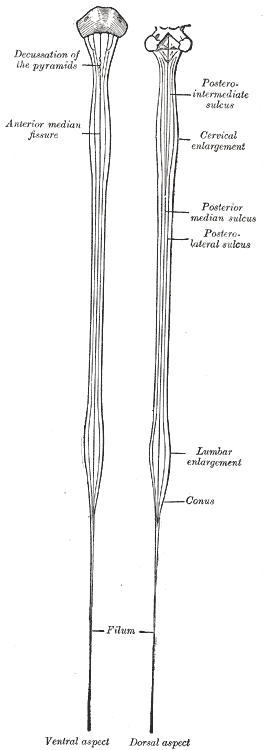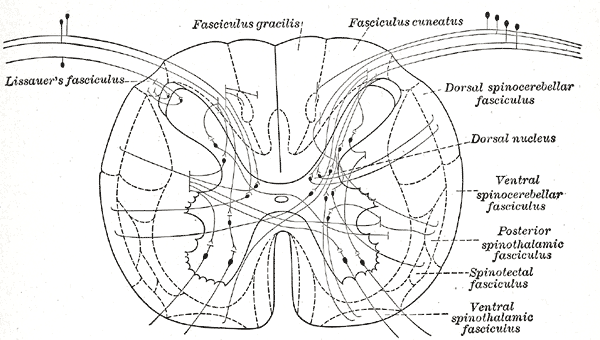[1]
Bican O, Minagar A, Pruitt AA. The spinal cord: a review of functional neuroanatomy. Neurologic clinics. 2013 Feb:31(1):1-18. doi: 10.1016/j.ncl.2012.09.009. Epub
[PubMed PMID: 23186894]
[3]
Frostell A,Hakim R,Thelin EP,Mattsson P,Svensson M, A Review of the Segmental Diameter of the Healthy Human Spinal Cord. Frontiers in neurology. 2016
[PubMed PMID: 28066322]
[5]
Takami T, Naito K, Yamagata T, Ohata K. Surgical management of spinal intramedullary tumors: radical and safe strategy for benign tumors. Neurologia medico-chirurgica. 2015:55(4):317-27. doi: 10.2176/nmc.ra.2014-0344. Epub 2015 Mar 23
[PubMed PMID: 25797779]
[6]
Vedantam A, Koyyalagunta D, Bruel BM, Dougherty PM, Viswanathan A. Limited Midline Myelotomy for Intractable Visceral Pain: Surgical Techniques and Outcomes. Neurosurgery. 2018 Oct 1:83(4):783-789. doi: 10.1093/neuros/nyx549. Epub
[PubMed PMID: 29165656]
[11]
Devivo MJ. Epidemiology of traumatic spinal cord injury: trends and future implications. Spinal cord. 2012 May:50(5):365-72. doi: 10.1038/sc.2011.178. Epub 2012 Jan 24
[PubMed PMID: 22270188]
[12]
Chen Y, He Y, DeVivo MJ. Changing Demographics and Injury Profile of New Traumatic Spinal Cord Injuries in the United States, 1972-2014. Archives of physical medicine and rehabilitation. 2016 Oct:97(10):1610-9. doi: 10.1016/j.apmr.2016.03.017. Epub 2016 Apr 22
[PubMed PMID: 27109331]
[15]
Varacallo MA, Fox EJ. Osteoporosis and its complications. The Medical clinics of North America. 2014 Jul:98(4):817-31, xii-xiii. doi: 10.1016/j.mcna.2014.03.007. Epub 2014 May 9
[PubMed PMID: 24994054]
[16]
Varacallo MA,Fox EJ,Paul EM,Hassenbein SE,Warlow PM, Patients' response toward an automated orthopedic osteoporosis intervention program. Geriatric orthopaedic surgery & rehabilitation. 2013 Sep
[PubMed PMID: 24319621]
[19]
Cornett CA,Vincent SA,Crow J,Hewlett A, Bacterial Spine Infections in Adults: Evaluation and Management. The Journal of the American Academy of Orthopaedic Surgeons. 2016 Jan
[PubMed PMID: 26700630]
[21]
Garg S, Dormans JP. Tumors and tumor-like conditions of the spine in children. The Journal of the American Academy of Orthopaedic Surgeons. 2005 Oct:13(6):372-81
[PubMed PMID: 16224110]
[22]
Al-Qurainy R,Collis E, Metastatic spinal cord compression: diagnosis and management. BMJ (Clinical research ed.). 2016 May 19
[PubMed PMID: 27199232]
[31]
Ng KS, Abdul Halim S. Anterior spinal cord syndrome as a rare complication of acute bacterial meningitis in an adult. BMJ case reports. 2018 Oct 24:2018():. pii: bcr-2018-226082. doi: 10.1136/bcr-2018-226082. Epub 2018 Oct 24
[PubMed PMID: 30361450]
Level 3 (low-level) evidence
[32]
Liu J, Li Z, Ye R, Liu J, Ren A. Periconceptional folic acid supplementation and sex difference in prevention of neural tube defects and their subtypes in China: results from a large prospective cohort study. Nutrition journal. 2018 Dec 12:17(1):115. doi: 10.1186/s12937-018-0421-3. Epub 2018 Dec 12
[PubMed PMID: 30541549]
[33]
Diaz E,Morales H, Spinal Cord Anatomy and Clinical Syndromes. Seminars in ultrasound, CT, and MR. 2016 Oct
[PubMed PMID: 27616310]
[34]
Zeng Y, Ren H, Wan J, Lu J, Zhong F, Deng S. Cervical disc herniation causing Brown-Sequard syndrome: Case report and review of literature (CARE-compliant). Medicine. 2018 Sep:97(37):e12377. doi: 10.1097/MD.0000000000012377. Epub
[PubMed PMID: 30213001]
Level 3 (low-level) evidence
[35]
Roth EJ,Park T,Pang T,Yarkony GM,Lee MY, Traumatic cervical Brown-Sequard and Brown-Sequard-plus syndromes: the spectrum of presentations and outcomes. Paraplegia. 1991 Nov
[PubMed PMID: 1787982]
[36]
Dave BR,Samal P,Sangvi R,Degulmadi D,Patel D,Krishnan A, Does the Surgical Timing and Decompression Alone or Fusion Surgery in Lumbar Stenosis Influence Outcome in Cauda Equina Syndrome? Asian spine journal. 2018 Nov 27
[PubMed PMID: 30472822]


